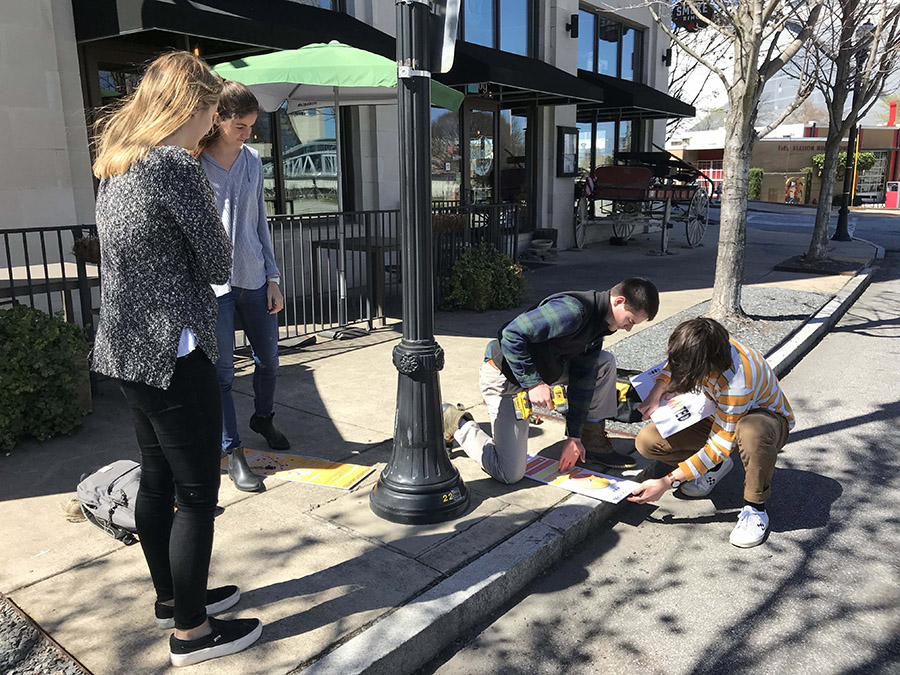Ted Turner Drive Re-design Competition Win 2018
 Students (l to r): Megan Daniel, Halle Salisbury, Matthew Cartledge, Jack Cherry
Students (l to r): Megan Daniel, Halle Salisbury, Matthew Cartledge, Jack Cherry
The swath that Ted Turner Drive cuts through the heart of downtown Atlanta is a Blade Runner landscape: no soul, unrelenting high-speed traffic on four lanes, and no pedestrians or much in the way of signs of life in general. People take their lives in their hands just crossing the multi-lane in-town throughway.
“It has no spirit, no personality,” says Jack Cherry, a fourth year Bachelor of Landscape Architecture student at the UGA College of Environment and Design (CED). “Or at least that’s what it seems like at first.” In fact, once his studio class immersed themselves in the neighborhood, under the direction of Associate Professor Doug Pardue, he and his fellow classmates discovered a provocative truth: Ted Turner Drive is actually a nexus of several historic neighborhoods. These could remain threatened by continued choking automobile traffic and insensitive gentrification or they could be enhanced and empowered with some interesting urban planning devices.
“What we discovered is that there are actually a lot of different urban conditions happening simultaneously on that street, which was once a hub of black commerce in Atlanta. Yes, there is a lot of homelessness, a lot of areas where it’s impossible to walk, but once we hung out there and visited small businesses and talked to people, we started seeing this as maybe a place that could guide change rather than just be a dangerous thoroughfare. There are already little gems of burger joints and coffee shops; we envisioned flex spaces where people can engage in the gig economy,” explained Jack.
The Atlanta Mayor’s Office of Resilience offered up a competition for students of planning and design in 2017. In the spring of 2018 students from Georgia Tech, Clark Atlanta University, Morehouse College and the University of Georgia took up the challenge and UGA’s College of Environment and Design won.
“I think the people who instigated the competition were looking for sort of a ‘poster child’ of resiliency design,” says Doug Pardue, “but we dug even deeper. An unrelenting wall of cars, poor infrastructure, and little regard for the human potential of the surrounding neighborhoods made us see this as more of a challenge to find a set a strategies rather than one ‘beautiful’ solution. We decided to activate it as a human event corridor.” He hopes their plan will get people to re-think their city, not just patch up problems. “Atlanta is actually doing a lot of good stuff already, there are strong assets for creating true resiliency there. Its diversity is key and we tried to offer ideas that honors the city’s unique qualities and be frugal about it: unleash what is there in the layers of economic and cultural energy.”
Pardue thinks a team of his students won because of the complementary skill sets of its members. Included on the team were: Katie Boucek, Jack Cherry, Sarah Franklin, Luke Gregory, Sophia Kim, Kayla Lord, Kiet Nguyen, Charles Quinn, Halle Salisbury, and Brittany Thompson. In addition to conducting research about the history of the area, students spoke with pedestrians and business owners. Using on-the-street “guerilla” design tactics and design games for three weeks, the students tried to get Atlantans to explore their own city, become more aware of their surroundings. In the process, they also tried to teach ideas about resiliency, not in a science-heavy way, but in an engaging way that people on the street could comprehend.
Pardue’s class used the extensive work that a studio class earlier in the year completed under the direction of Alfie Vick, also an associate professor at CED. The team won $2500 and a lot of satisfaction in beating the urban colleges and universities in Atlanta.
The Mayor’s Office of Resilience sponsored the competition; implementation partners included Renew Atlanta and city’s the Department of Parks and Recreation; and funding came from Turner Enterprises, Rebuild by Design, T-SPLOST.
The winning presentation titled “Spark” can be found at: https://athenaeum.libs.uga.edu/handle/10724/38516
